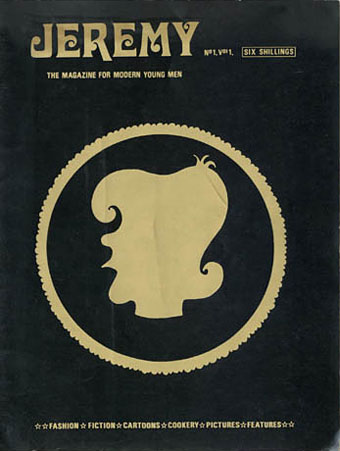
Jeremy, vol. 1, no. 1.
To note the 50th anniversary this month of the (partial) decriminalisation of homosexual acts in England and Wales I thought I’d write something about Jeremy magazine, a short-lived publication launched in the UK in 1969. The magazine is notable not for the quality of its contents, which seem slight considering the high cover price of six shillings, but for being the first British magazine aimed at an audience of gay men that wasn’t either porn, a dating mag or a political tract. I had planned to write something about Jeremy at least two years ago when the blog was still a daily thing but detailed information about the magazine’s history is hard to find. This is frustrating but not too surprising. The anniversary of the change in the law has prompted a number of exhibitions and events devoted to Britain’s gay history but little of that history ever seems to travel beyond academic circles unless a notable life story—Quentin Crisp or Alan Turing, say—is involved. As with so many aspects of British culture, the conversation is dominated by America: the main campaigning organisation in the UK, Stonewall, is named after an American riot; the LGBT initialism is an American invention, as is the rainbow flag (the latter, as I’ve said before, being fine as a flag but—with its multiple colours—hopeless as a symbol). More Britons will know the name Harvey Milk than they do Edward Carpenter (1844–1929) or Allan Horsfall (1927–2012) even though Carpenter and Horsfall devoted years of their lives campaigning for gay men to be treated equally under the law in the Britain. Horsfall’s Campaign for Homosexual Equality pioneered the push for gay rights in Britain, the first official meeting taking place in Manchester in 1964. The Sexual Offences Act of 1967 seemed in later years like a poor compromise but when the alternative being offered was celibacy or the risk of a prison sentence it was a start. (Scotland, however, had to wait until 1980 for the same change in the law while in Northern Ireland sex between men was illegal until 1982.) Two years after decriminalisation, not only was Jeremy being launched but OZ magazine devoted a portion of its 23rd issue (September, 1969) to gay material. Jeremy advertised its early issues in OZ and IT (see below).
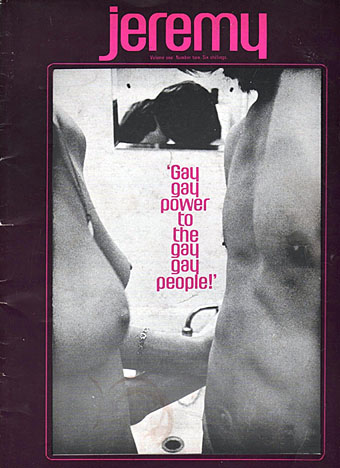
Jeremy, vol. 1, no. 2.
Jeremy‘s status as the first gay magazine in Britain might be more acknowledged if its origins weren’t so obscure. The magazine is mentioned in books such as British Queer History (edited by Brian Lewis) and The Culture of Queers by Richard Dyer but never in any detail. Dyer refers to the title as a bisexual magazine which it may have appeared to be from the covers but this is contradicted by the ads. Peter Burton, editor of the later issues, claimed that everyone involved knew that gay men were the primary audience. Using bisexuality as a kind of fig leaf was less a case of cold feet than a means by which the magazine might be smuggled under the radar of those who would otherwise object to its existence. Britain may have been slightly ahead of the US in its tolerance of gay men but the lack of a written constitution meant that publishers, especially those regarded as subversive or disreputable, needed to tread carefully in the 1960s and 70s as OZ and Nasty Tales discovered.
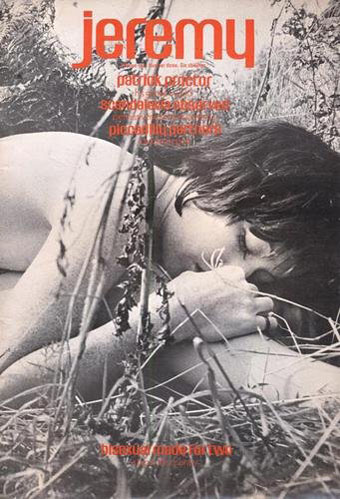
Jeremy, vol. 1, no. 3.
The precarious legal position means that Jeremy‘s visuals are relatively innocuous, with sporadic nudity but nothing that might be regarded as pornography. The magazine’s features were also relatively innocuous although the novelty of publishing anything overtly gay meant that a piece about entertaining at home would carry a frisson that would be absent in other magazines. Later issues included encounters with minor celebrities including an early interview with David Bowie which has at least preserved the magazine’s name in Bowie histories. Bowie had the opportunity to be open about his sexuality but wisely waited until his profile had risen and he could make a declaration to a larger audience.
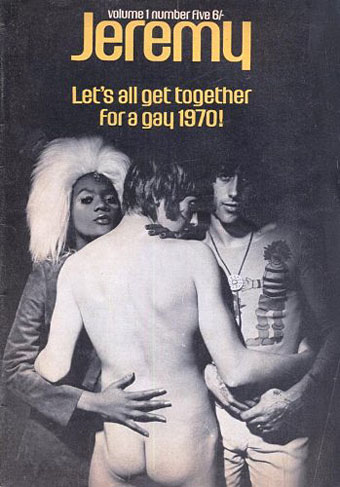
Jeremy, vol. 1, no. 5.
A few more covers and some interior pages follow. As usual, if anyone has further information to contribute then please leave a comment. My thanks to Rex for sending the information about Peter Burton’s editorship of the magazine.
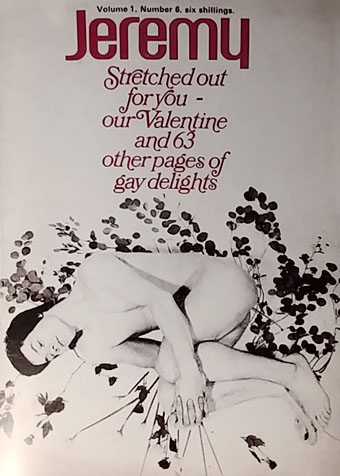
Jeremy, vol. 1, no. 6.
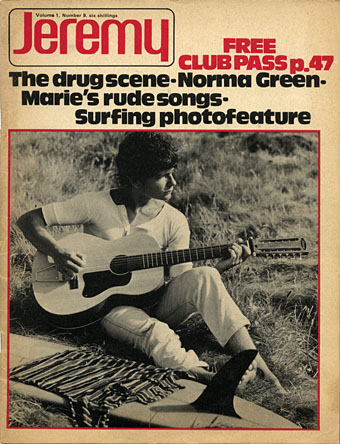
Jeremy, vol. 1, no. 9.
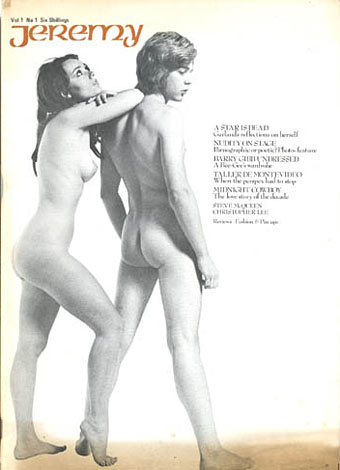
Jeremy, vol. 1, no. 1.
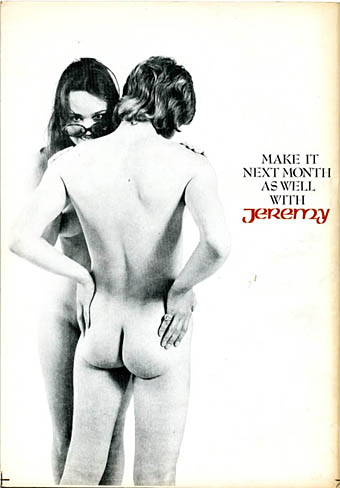
Jeremy, vol. 1, no. 1.
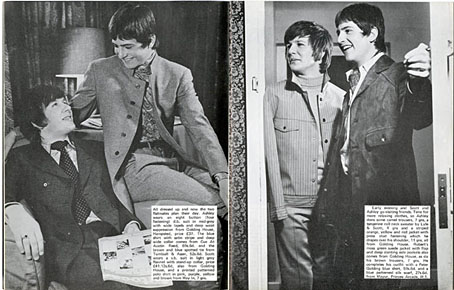
Jeremy, vol. 1, no. 1.
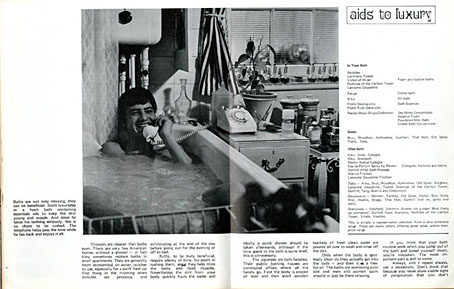
Jeremy, vol. 1, no. 1.
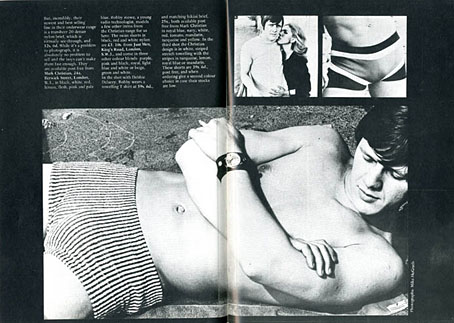
Jeremy, vol. 1, no. 1.
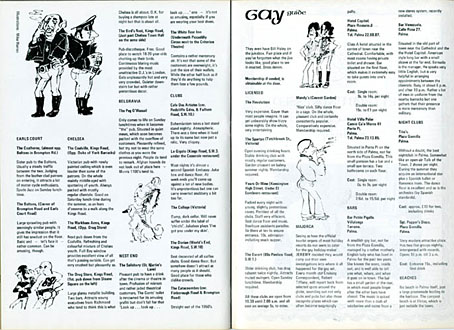
Jeremy, vol. 1, no. 1.
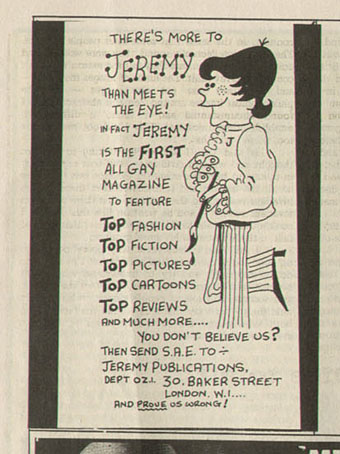
OZ 19, March 1969.
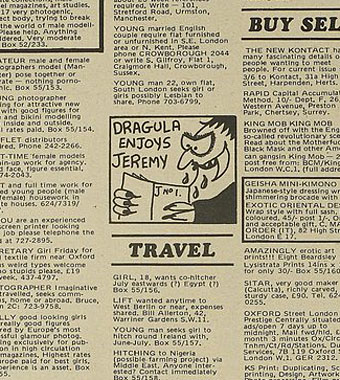
International Times, April 25, 1969.
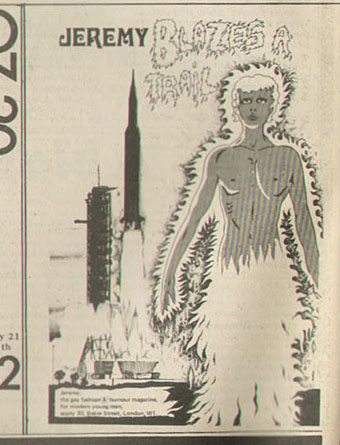
OZ 20, April 1969.
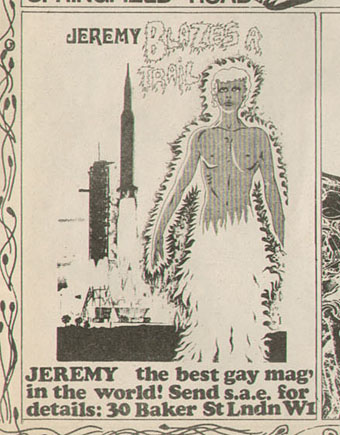
OZ 21, May 1969.
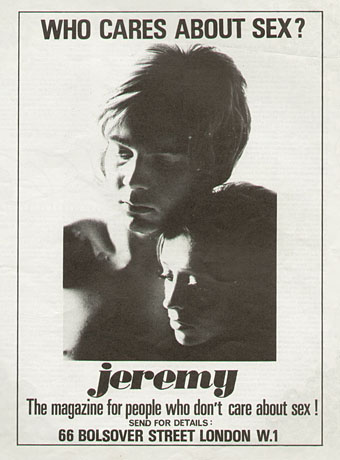
OZ 22, July 1969.
Previously on { feuilleton }
• Gay slang from the 1970s

Thanks for writing about Jeremy, the Magazine for Modern Young Men. It really was daring for its time.
I just happened to find your website by accident, in a google search for Rex, the gay erotic artist. I have some copies of his famous prints that he so kindly sent me years ago, which I recently found stored in a box.
What a lucky find indeed. Now I can learn more about gay media, some I missed, others I participated in like the zine craze of the late 80’s like the Polished Knob and Scott O’Hara’s zine, Steam.
Looking at the covers of Jeremyabove there seems to be 2 different covers both Vol 1 Issue 1. See first and 7th. I am confused. I found a copy of the latter when I bought a batch of early OZ magazines.
ritt: Thanks. You’d think after 50 years this history would be better documented but it doesn’t seem to be outside academic lists. Once again, the US is better served by book-length studies of gay zine culture and the like.
deepinder: This is only my assumption, but both covers appear to be from the same issue which–according to Peter Burton–was subscription-only at first. I found all the images for issue 1 on the same auction page so they seem to be the same publication. This is what I mean about information being scarce/confusing. A lucky find for you, anyhow, even if not as collectable as OZ!
It indeed was a lucky find. It must be about 1990 so quite a long time ago. The BBC 4 channel has broadcast an excellent programme in which there was a visit to the original publisher of Jeremy who gave some insight into some of the problems they overcame. The other interesting publication seen was ‘Come together’ and a few fragile copies were revealed in an ephemera ‘one upmanship’!
I didn’t know about the TV feature but then I haven’t owned a television for years. I’d expect a mention of it somewhere since there’s been a lot of discussion around the 50th anniversary of the change in the law.
One detail I didn’t include above was that Robert Lacey was editor for a short time, an odd choice when (as far as I know) he’s straight. Better known today for his books about the Royal Family.
Another small gay mag (or fanzine) from the period was Synthesis which I’ve seen described as a satirical publication. It doesn’t help when searching for information that the titles of these things are so general.
The issue of No 1 above is the front & rear cover. It’s definitely not two different covers. I sold a copy of this a few years back on my website. I’ve a large collection (300+) of 1970s gay scene magazines like Gay News, Advocate, After Dark and a few odd copies of Jeremy that I will be listing over the next few weeks.
Doh! Just seen the one at the top of the page.
Ah, thanks! I think it was your pictures I found. The images here have been trawled from all over.
The name of the BBC 4 TV doc series is: Prejudice and Pride: The People’s History of LGBTQ Britain. It is presented by Stephen K Amos and Susan Calman. In the same way as Vertity Lambert’s Naked Civil Servant, the programme is a very human look at the problems and the prejudices. There is a shocking 1970 interview with a policeman who was clearly on the prowl for victims which caused me to think he was a one man sadists charter. I think you are very wise not to have a TV but you can see this excellent programme on the BBC iplayer. http://www.bbc.co.uk/programmes/p0578x02
Thanks, my net connection is too sluggish for iPlayer but many of these things turn up on YouTube eventually. There used to be a very good torrent site for UK TV but it closed down.
It’s good for people to be reminded how violent and oppressive the police in this country were towards any minorities or those with anti-establishment sympathies/interests. They may be more gay-friendly today but into the 1990s they were still harassing gay people, raiding shops for porn, etc. The Manchester police had a particularly bad reputation, the Spanner case being only the most notorious of many such instances:
https://en.wikipedia.org/wiki/Operation_Spanner
The BBC have handily transcribed the Jeremy bit and made a little magazine section if you will online. See here for the excellent BBC photos
http://www.bbc.co.uk/news/resources/idt-sh/lgbtq_how_we_got_to_now